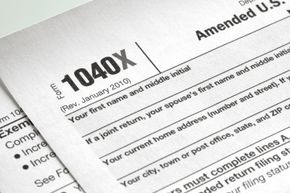Few things are less fun than figuring out one's taxes. For millions each year in the United States, April 15 looms as the due date for filing an income tax return to the IRS. In order to fill out a return properly and make sure you are not underpaying or overpaying, you must use diligent record keeping throughout the year, understand complex tax terms, be familiar with myriad deductions and keep up-to-date with changes.
The U.S. tax code is highly complicated, making the process confusing for average Americans. On top of this, it can be extremely frustrating when you sit down to calculate this year's tax return only to discover that you made a mistake on last year's return.
Advertisement
Understandably, mistakes happen. To help, the IRS provides the Form 1040X, a form dedicated to amending a previously submitted tax return. If a taxpayer forgot to report some freelance babysitting income on last year's return or overlooked some investment income used to pay for home improvements, the IRS could require past-due taxes with interest.
Tax experts generally say that it's best to pay this as soon as possible, rather than hope the IRS overlooks it, because the longer a taxpayer waits, the more interest accrues, and the IRS could charge a penalty on top of that. Other times, amending a tax return can benefit a taxpayer and provide a refund from the IRS.
Before you begin going over the 1040X form itself, you'll have to determine whether this is the appropriate form for you. We'll then discuss how much time the IRS allows to submit the form. And, although the IRS tries to make this form easy to follow, it can still seem complicated to navigate. Indeed, the IRS estimates that it takes the average taxpayer a full nine hours and an out-of-pocket cost of $160 to complete and submit the form [source: IRS 1040X Instructions]. So, we'll go over the form and the instructions to help you understand them. Finally, you'll have to include all required documentation and make sure to mail it to the right place.
Advertisement







